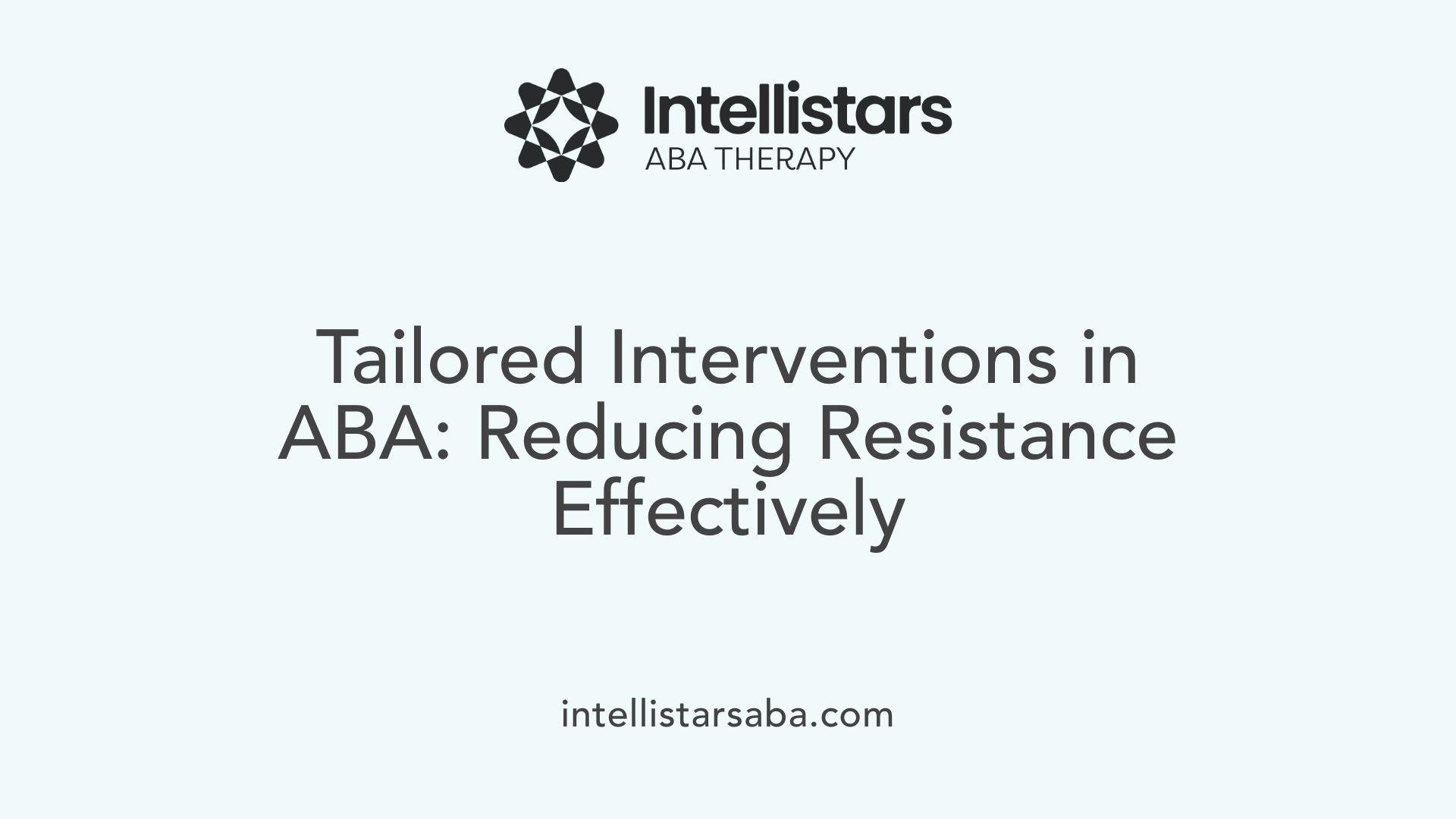Understanding Resistance to Change in Individuals with ASD
Resistance to change is a common challenge faced by children with Autism Spectrum Disorder (ASD). To foster more adaptive and flexible behaviors, it is essential to understand the underlying factors that contribute to this resistance, primarily rooted in neurological and psychological reasons. This comprehensive overview explores how ABA therapy can be utilized to address these challenges effectively, promoting growth, resilience, and independence in children with ASD.
Factors Contributing to Resistance in ASD

What factors contribute to resistance to change in individuals with Autism Spectrum Disorder (ASD)?
People with ASD often show resistance to change due to a combination of neurological, sensory, emotional, and behavioral factors. Sensory sensitivities play a significant role; many individuals experience sensory overload when faced with unfamiliar stimuli or sudden changes. This overload can cause discomfort or distress, leading them to cling to familiar routines that help manage sensory input.
Preference for routines and sameness is another crucial aspect. Predictability offers a sense of safety and control, reducing anxiety associated with the unknown. When routines are disrupted, individuals may react negatively, showing resistance or distress.
Emotional fears, particularly of loss or separation, also contribute to this resistance. Many individuals with ASD fear losing contact with loved ones or familiar surroundings, making routine behaviors a method of coping and ensuring continuity.
From a neurological perspective, differences in how sensory information is processed can impair adaptability. These neurological differences make it harder for individuals to handle new situations, causing a strong reliance on familiar patterns.
Additionally, deficits in cognitive flexibility — the ability to shift thinking and adapt to new information — limit the capacity to change routines or behaviors smoothly. These challenges are reinforced by automatic negative behaviors, making resistance a persistent issue.
Addressing resistance involves early intervention strategies such as visual supports, caregiver training, and structured routines. These approaches aim to reduce anxiety, improve flexibility, and gradually introduce change, helping individuals with ASD navigate their environments more comfortably.
| Factor | Description | Supporting Details |
|---|---|---|
| Sensory sensitivities | Overload from unexpected stimuli | Leads to avoidance of new environments |
| Preference for routines | Need for predictability to feel secure | Resistance intensifies when routines are disrupted |
| Fear of loss or separation | Anxiety about losing contact or familiar settings | Drives need for sameness as comfort |
| Neurological impacts | Differences in sensory processing affecting adaptation | Difficulties in handling new stimuli |
| Cognitive flexibility | Ability to shift between tasks or thoughts | Challenges in accepting change |
Understanding these factors can guide caregivers and therapists in designing supportive interventions. Tailored strategies can gradually reduce resistance, making change less distressing and more manageable.
Applying ABA to Reduce Resistance: Core Principles and Approaches

How can Applied Behavior Analysis (ABA) therapy be used to reduce resistance to change in children with ASD?
Resistance to change in children with Autism Spectrum Disorder (ASD) often stems from underlying fears or sensory challenges. ABA therapy offers targeted strategies to address this resistance by focusing on understanding the function of behaviors and modifying environmental factors.
One effective method involves using Differential Reinforcement of Alternative behaviors (DRA) combined with escape extinction procedures. These techniques help increase a child's tolerance to change while reducing problem behaviors associated with transitions. For example, by reinforcing adaptive responses such as asking for a break or demonstrating calmness, therapists can encourage more independent coping.
A crucial step is conducting a Functional Behavior Assessment (FBA). This assessment helps identify why a child resists change—whether it is due to sensory overload, fear of loss, or difficulty coping with uncertainty. Knowing the function guides the development of personalized interventions.
Environmental modifications also play a vital role. Using visual schedules, offering choices, and designing predictable routines reduce anxiety and make transitions smoother. These tools help children anticipate what will happen next, lessening feelings of uncertainty.
Data-driven adjustments ensure therapies remain effective. Therapists continually monitor behaviors, analyze data, and adapt strategies—such as tweaking reinforcement schedules or modifying environmental supports—to fit the child's evolving needs.
In summary, ABA's structured, individualized approach tackles the root causes of resistance. By understanding behavioral functions and applying specific modifications and reinforcement strategies, ABA helps children with ASD become more comfortable with change, promoting greater resilience and independence.
Effective ABA Strategies for Promoting Flexibility

What are effective ABA techniques for addressing resistance to change in children with ASD?
Addressing resistance to change in children with ASD requires a thoughtful combination of techniques grounded in Applied Behavior Analysis (ABA). A crucial first step is conducting a functional behavior assessment (FBA), which helps identify the specific reasons behind a child's resistance, whether it's sensory overload, fear of separation, or difficulty understanding new routines.
Once the underlying causes are known, therapists can tailor interventions that promote adaptability. One effective approach is to use positive reinforcement—rewarding desired behaviors to encourage flexibility and cooperation. Visual supports such as visual schedules, social stories, and cue cards serve as clear guides, reducing uncertainty and anxiety about upcoming changes.
Priming and modeling are additional strategies where the therapist or caregiver introduces the new transition or activity beforehand. Through role-playing or demonstrations, children learn what to expect, making the change seem less intimidating. For example, showing a child a picture of a new activity or role-playing the transition can diminish resistance.
Creating predictable environments by establishing structured routines and visual cues helps children feel secure. Consistent schedules and clear expectations minimize surprises, which are often sources of distress.
Gradual exposure and desensitization are important components. Starting with small, manageable changes allows children to build confidence and familiarity over time. Role-playing or using visual countdowns can prepare children for upcoming changes incrementally.
Functional communication training (FCT) provides children with the tools to express their needs and feelings, reducing frustration and opposition. Teaching alternative, functional ways of requesting or commenting helps children gain a sense of control.
Combining these strategies leads to more adaptive responses. The approach should always be individualized, considering each child's preferences and sensitivities. Research supports that utilizing visual supports, priming, and structured routines collectively enhances flexibility and reduces resistance, promoting more successful therapy outcomes.
The Role of Managing Resistance in Therapy Outcomes
How does managing resistance to change enhance therapy outcomes in children with ASD?
Managing resistance to change in children with ASD plays a crucial role in improving therapy outcomes by fostering increased engagement and participation. Resistance often manifests through behaviors such as avoidance, arguing, or withdrawal, which can hinder the learning process. When therapists effectively address these barriers—using strategies like pairing, positive reinforcement, and open communication—they create a more receptive environment.
One effective approach involves combining Differential Reinforcement of Alternate behavior (DRA) with escape extinction. This technique helps children tolerate change by rewarding alternative, more adaptive responses while minimizing behaviors aimed at avoidance. As resistance decreases, children are more open to participating in activities, making it easier to teach new skills.
Reducing resistance not only improves immediate engagement but also aids in the generalization of learned behaviors to real-life settings such as home, school, and community environments. When children are less resistant, they can better adapt to new routines and expectations, which supports long-term developmental progress.
Furthermore, managing resistance can promote resilience. Environmental supports like involving family, community, and social networks help children cope with change and adversity. These supports foster a sense of safety and confidence, enabling children to navigate challenges more effectively.
In summary, addressing resistance to change enhances therapy effectiveness by boosting participation, facilitating skill transfer, and nurturing resilience. This holistic approach ensures that children with ASD not only learn new behaviors but also develop the adaptive capacities needed for lifelong success.
Tailoring ABA for PDA and Autism: Personalization Strategies
How can ABA methods be adapted to support behavioral flexibility in individuals with PDA or autism?
Adapting Applied Behavior Analysis (ABA) techniques to support flexibility involves a mix of gradual and personalized strategies. One effective approach is gradually desensitizing individuals to change and transition through gradual exposure. This helps reduce anxiety over time and facilitates more adaptive responses.
Visual supports, such as picture schedules and visual cues, play a vital role in providing predictability and a sense of control. These tools help individuals anticipate what will happen next, easing the impact of unexpected changes.
Reinforcement strategies are tailored to encourage flexible behaviors. This could include rewarding attempts to shift attention, adapt to new routines, or tolerate disruptions without resorting to avoidance. These positive reinforcements should align with the person’s interests and motivations.
Sensory sensitivities are common in autism and PDA, so interventions must address these sensitivities carefully. Creating a sensory-friendly environment and introducing sensory breaks can help manage overstimulation, preventing escalation of resistance.
Building emotional regulation skills is crucial. Techniques such as emotion recognition, deep breathing, and mindfulness training can help individuals manage their anxiety and emotional responses better.
A family-centered, collaborative approach is essential. Engaging families in training, planning, and decision-making ensures consistency across settings and enhances the effectiveness of interventions. It also respects each individual’s unique needs, preferences, and responses.
In cases like PDA, where resistance to traditional ABA methods is common, customizing strategies based on thorough functional assessments helps. These assessments identify specific triggers and functions of avoidance behaviors, allowing for more precise and supportive interventions.
Interventions should be dynamic, adjusting to fluctuating anxiety levels and behavioral responses. Incorporating social skills training and resilience-building exercises supports long-term flexibility.
Training parents and caregivers to implement these strategies at home fosters a coherent approach and provides additional reinforcement and consistency.
Emphasizing emotional regulation and collaboration helps create a supportive environment that respects individual differences while promoting behavioral flexibility and reducing resistance.
Supporting Change and Embracing Flexibility
Successfully reducing resistance to change in children with ASD through ABA therapy requires a nuanced understanding of underlying factors, a personalized approach, and consistent data-driven adjustments. Employing strategies such as visual supports, functional communication, gradual desensitization, and positive reinforcement can significantly improve behavioral flexibility. Building a supportive environment that fosters trust, resilience, and autonomy not only enhances therapy outcomes but also promotes lifelong adaptability. As therapists and caregivers collaborate to implement these approaches with patience and empathy, children with ASD can develop the confidence to face change and thrive in diverse settings.
References
- Resistance To Change In People With Autism Spectrum ...
- Client Resistance in Therapy: How to Help Difficult Clients
- Understanding Behavior Reduction Techniques in ABA ...
- Pathological Demand Avoidance (PDA) and Autism
- What to Do If Your Child Resists ABA Therapy
- A Review of Behavioral Strategies and Support ...
- Overcome Resistance in ABA Therapy | Autism Support
- ABA Therapy Techniques to Help Your Child Handle Change






